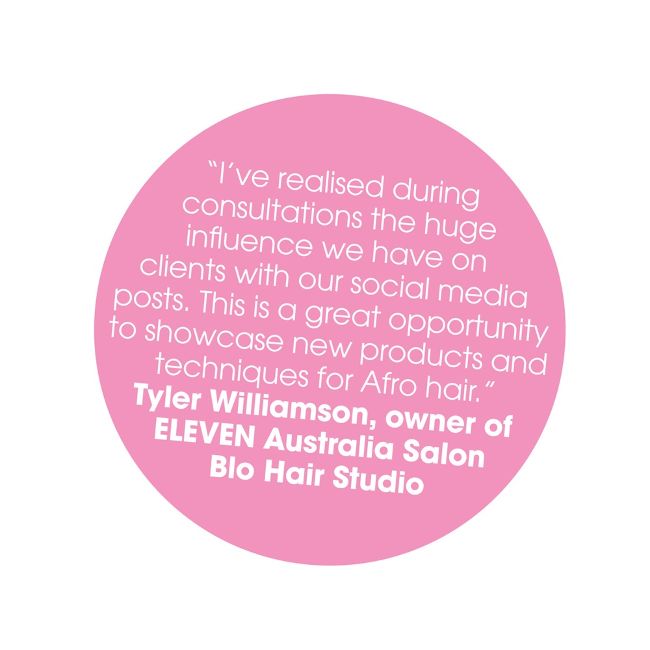COLOUR
COLOURING AFRO HAIR
HJ asked the experts to answer your burning questions about colouring Afro hair
“With Afro hair always check if your client has had any chemical treatments, such as relaxers. This will determine the colour to be applied,” advises Tracy Hayes, Fudge Professional global colour ambassador. “If so, a complete colour change to blonde may not be possible without forfeiting the condition. If in doubt always do a colour strand test,” she says.
“Preparation and consultation are key for any colour client,” adds Joe Hill, Aveda UK international technical capability manager. “When approaching colour for a client with a textured hair type, anything from 3b to 4c, a pre-treatment is almost like the insurance to your colour service. This will help with manageability when combing and sectioning the hair throughout the colour service,” he says. “Textured coloured hair can often be very porous.
That’s why I love to work with a porosity equaliser like Aveda’s Botanical Repair Equalising Primer. This is sprayed throughout the hair just before applying the colour to prime the cuticle and cortex ready for the colour,” he says.
“The curlier the hair, the less even the distribution of keratin,” explains Vivica Davies, ALFAPARF Milano international educator. “Extreme lightening services, such as bleaching, can alter the curl pattern.
Therefore, it is important to approach extreme lightening carefully, to minimise damage and help maintain the elasticity and vitality of the curl. The first step is to check the condition of the hair fibre to ensure it is strong enough to withstand a bleaching service,” she says.
“Combine this with a type 4 fine texture, and the result is a hair texture that is particularly delicate. Using a permanent colour, such as ALFAPARF’s Evolution of the Color, on natural hair will not alter the shape of the hair, since it creates a maximum of 4 levels of lightening and contains nutritive ingredients,” she says.
“Freehand hair colouring is a perfect choice for Afro hair as you can analyse the hair texture and where the curls fall to see which areas of the hair would look best highlighted,” explains Suzie McGill, Schwarzkopf Professional ambassador and international artistic director at Rainbow Room International.
She adds: “Hand painting and balayage is the best way to give the curls definition. It allows you to see the finished result and you can change certain placements where necessary. If placed correctly highlights will add a shine to the hair. Whereas if done incorrectly, they could make the hair appear dull.”
“Make sure your colour choices are realistic and are something the hair can withstand,” says Robert Eaton, creative director at Russell Eaton salons and UK and Ireland technical director at Wella Professionals.
“Safely bleaching hair is about assessing the quality, density and condition. My go-to is always low and slow,” adds Clayde Baumann, global colour director at D&J Ambrose and Wella Passionista.
He adds: “Afro hair needs a gentle touch and moisturising aftercare.”
“After lockdown we’ll see natural texture and curls,” predicts Tracy Hayes. “We’ll see lots of singular pieces of tonal colour being placed within the hair texture. When placing the colour take note of how the curls lay and pick accordingly.
Don’t be scared to take larger sections than you would on straight hair,” she says. “Always use plenty of product with Afro hair and work through each section to ensure an even colour distribution and finish.”
“One of the main points I discuss with my Afro clients prior to a vivid service is bleaching,” says Amber Letham, Crazy Color sponsored stylist. “Excessive bleaching isn’t worth the loss of a curl pattern,” she says. “If the hair hasn’t lifted enough to achieve the vivid goal, I’d rather work on the hair gently over a course of appointments than blast through the hair in one session and see the curls permanently drop,” she says. The team at Slunks Salon, a Crazy Color sponsored salon, add that home maintenance is important too. “Explain how they could top up their colour at home, such as adding Crazy Color into their shampoo or conditioner. We would recommend washing in cool water to help stop colour fading.”


“If you’re new to Afro hair listen to your clients’ needs first,” says Marco Dias, owner of The Studio by Marco Dias and a Wella Passionista. “Afro clients will definitely know what is lacking in their own hair. Aftercare is about depositing back all hydration and nutrients lost from the hair when we colour it with oils and proteins. The Nutricurls line from Wella Professionals is one of my favourites,” says Marco. Mark Leeson, Revlon Professional global artistic ambassador agrees. He says: “Daily maintenance is key and while washing hair should be kept to once or twice a week, make sure clients know to moisturise their hair every day. I love Revlon Professional Equave Instant Detangling Leave In Conditioner. It locks the moisture in but is light enough to not affect curls and coils.”

“Schwarzkopf Professional BLONDME bleach is my go-to product for lightening Afro hair because the bonding technology is built into the product,” says Tim Scott-Wright, Schwarzkopf Professional ambassador. “Afro hair will soak up colour like a sponge as its structure means bleach can take a while to penetrate through,” he explains. “The colour will take a long time to lift initially, but once it starts, it lifts very quickly. Keep a close eye on bleach when colouring Afro hair and reapply where the hair needs it. The reapplication process is important as the hair texture is quick to absorb the product,” he adds.